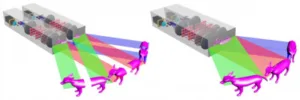Daping Chu, within the Centre for Photonic Devices and Sensors at the University of Cambridge (Cambridge, UK), is leading a team that includes collaborators from Disney Research (Glendale, CA) in the development of a new method to produce large holographic displays. The approach used by the team is based on stacking so-called Holobrick devices.

Two points of background information are offered to start this article.
First, a major challenge in creating a high quality holographic image is the need to deal with the issue of the high volume of data required to produce the image. The difficulty in addressing the data issue increases along with an increase in the field of view and/or the resolution of the image.
Stating this challenge once again, this time from the perspective of hardware. The information content and associated bandwidth required to produce a large, high resolution holographic image is much greater than the capabilities of the spatial light modulators that form the basis of the current generation holographic light engines.
The second point is that, in 2D display technology, a well-known means to produce a large display is to tile multiple small displays.
Clearly, taken together, these two points suggest that a means to produce a large holographic display is to combine the output of multiple small holographic displays. Yet….up to now, this has not been successfully accomplished. The reason is that joining multiple holographic images is very difficult due to the requirement that the final image must appear seamless from all angles and depths. To address this challenge, the team developed the Holobrick.
The Holobrick
A recent article on this topic by the team is entitled “Holobricks: modular coarse integral holographic displays.” It was published in Light: Science & Applications, 2022; 11 (1). A copy of the article is available here.
Each Holobrick is a self-contained device optimized for the delivery of high information content. It includes a coarse pitch, small area, high bandwidth spatial light modulator. In addition, each Holobrick device uses a periscopic, coarse integral optics optical system. (One definition of periscopic is: permitting the observation of objects from positions in or out of the direct line of sight.)
As explained in detail in their article, the use of periscopic coarse integral optics prevents the optical system from being larger than the holographic image and allows the holographic fringe pattern to fill the entire face of the Holobrick. The bottom line is that, by this means, multiple Holobrick devices can be seamlessly abutted to form a scalable, spatially tiled holographic image having both a wide field of view and an arbitrarily large size.
The team reports on the demonstration of an initial prototype holographic display system that seamlessly tiles two Holobrick devices. The specifications of each Holobrick includes the following: resolution of 1024 x 768 pixels, full color, 40 degree field of view and video at 24 frames per second.
The figure below illustrates the tiling of two Holobrick devices.
 The spatial tiling of two Holobrick devices. The two Holobricks together are capable of displaying full parallax, computer generated, digital holograms.
The spatial tiling of two Holobrick devices. The two Holobricks together are capable of displaying full parallax, computer generated, digital holograms.
In the conclusion of their article, the team stated that Holobricks demonstrated good performance in a range of visualization tasks that included 2D holographic images, holographic stereograms of physical objects and holograms of computer generated objects. The team went on to speculate that the excellent performance of Holobricks combined with the scalability of the devices suggests that this approach may succeed as one of the future architectures for 3D displays. –Arthur Berman
University of Cambridge, Daping Chu, [email protected]

